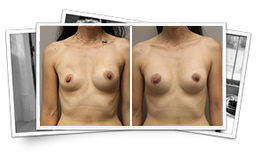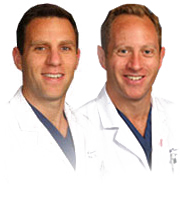Implant Replacement Thousand Oaks
Many women with breast implants will need their implants replaced at some point in their lives. This can be for a number of reasons such as: hardening of the tissue around the implant and distortion of the breast (capsular contracture); rupture or leakage of the implant; displacement of the implant into an abnormal position; a desire to increase the size of the implant; and droopiness (ptosis) of the breast tissue overlying the implant. Replacement of the implant alone is often not sufficient to correct the problem. Other adjunct procedures such removal of the capsule around the implant, adjusting the pocket that the implant sits in, or performing a breast lift may be required.
Before & After Photos
 Implant Replacement Surgery
Implant Replacement Surgery
At the Kryger Institute of Plastic Surgery, we have experience in a vast array of surgical and non-surgical procedures. Click below to see some before and after photos of implant replacements.
MORE IMPLANT REPLACEMENT PHOTOS
Who is a good candidate?
Any woman who is in good health and has breast implants that must be replaced may be a candidate. You must understand that if it has been many years since your initial breast augmentation and your breasts have become droopy, you may require a breast lift procedure (mastopexy) at the time of implant replacement.
What types of implants are there?
All breast implants are made of a silicone shell. The shell can be filled with either silicone gel (Silicone/Gel implants) or a salt-water solution (Saline implants). Silicone implants have recently been made available again to all women who are willing to participate in approved studies. We offer both types of implants. You should discuss the benefits and disadvantages of each type of implant with your surgeon. Some women are not good candidates for silicone implants. This will be determined at your initial consultation with your surgeon.
Planning your surgery
In your initial consultation, your surgeon will begin by evaluating your health. Be sure to tell your surgeon if you smoke, and if you’re taking any medications, vitamins, or other drugs. The surgeon will then explain which surgical technique and type of implant is most appropriate for you, based on the condition of your breasts and skin tone. If your breasts are sagging, your doctor may also recommend a breast lift. You and your surgeon will determine what size implant is best for you. In general, the larger the implant, the more unnatural it will appear. Some women, however, desire an “augmented” look and are good candidates for large implants. The breast implant can be placed using a number of different small incisions. You and your surgeon will choose the incision that will give you the best result and also meet your expectations.
Does insurance cover implant replacement?
Because most insurance companies do not consider breast augmentation to be medically necessary, carriers generally do not cover the cost of this procedure. It is important that you discuss all the costs and fees during your consultation. One exception that will usually be covered by insurance is implant replacement after breast reconstruction.
Preparing for surgery
You will be told which medications to stop and which to take before surgery. Aspirin and anti-inflammatory medications such as ibuprofen and Aleve must be stopped for 7 days before surgery. If you smoke, you must quit smoking entirely for 6 weeks before and 6 weeks after surgery. You must strictly follow the instructions about when to start fasting before surgery (usually at midnight). If you get sick or have any health issues in the days before surgery, please notify the office at once in case we have to postpone your operation.
The surgery and the incisions
The surgery usually takes 1-2 hours to complete. If a breast lift is also performed an additional 60-90 minutes is required. If all that is required is removal and replacement of your breast implant, the same incision that was used to place it can be used. If there is hardening of the tissue (capsule) around the implant, a slightly larger incision may be required to remove the capsule. For gel implants, the incision required is almost an inch longer than the incision used for saline implants since the gel implants come pre-filled and require more room to insert. Every effort will be made to ensure that the resulting scars will be as inconspicuous as possible. Remember that if you are undergoing a combined breast lift-augmentation, there will be additional scars related to the breast lift.
The anesthesia
Implant replacement can be performed under “twilight” anesthesia or general anesthesia. Twilight anesthesia consists of intravenous sedation and pain medication that keeps you relaxed and sleepy during the surgery. In addition, the surgeon uses local anesthesia to numb the abdomen. General anesthesia involves going completely to sleep with a breathing tube in your throat. There is a slightly higher risk of nausea and vomiting after general anesthesia, however both techniques are extremely safe. Your surgeon will discuss the anesthetic options with you before surgery.
What kind of dressings and drains are there?
You can remove the gauze dressings the day after surgery. If there is tape or adhesive strips directly on your incision, do not remove these. If they fall off in the shower there is no need for concern. Occasionally, an ACE bandage is used to provide gentle compression for comfort. You can continue to use this bandage or transition to a soft bra. Most women feel more comfortable wearing a sports bra for the first few weeks after surgery.
Implant replacement alone rarely requires the use of drains. If an additional procedure such as a lift or removal of the surrounding implant capsule is performed, one drain in each breast may be required. This will be determined by your surgeon at the time of surgery. These drains help drain the fluid that is produced under your skin as part of the healing process. Without drains, this fluid can accumulate, termed a seroma. Drains stay in until the drainage is less than 25 ml per drain in a twenty four hour period. This usually takes 5-7 days, but can be shorter or longer in some cases. The drains are easy to take care of, and do not hurt to take out.
Can you go home the day of surgery?
Implant replacement can be done safely as an outpatient, and most patients will be able to go home the same day. Some patients may prefer to spend a night or two in the hospital if they have young children at home or live alone and do not have any help at home.
How much pain is there after surgery?
Pain from implant replacement surgery is highly variable, and ranges from minimal to severe. It is worst in the first few days after surgery, but then it rapidly improves. It is impossible to predict a person’s expected pain. If you have done well with surgery in the past, you will likely be fine after this surgery. Our surgeons have a lot of experience treating pain, and have published scientific articles and written book chapters about anesthetics and pain control. They will do everything possible to minimize your pain, including using pain pumps after surgery and utilizing all the newest pain medication. By the end of the first week, most people’s pain is controlled with plain Tylenol or Motrin.
What about swelling and bruising?
Swelling and bruising are normal signs of the healing process. They occur after any surgery to varying degrees. Swelling peaks at about 48 hours, and then rapidly decreases. By the end of the first few weeks, 50 percent of the swelling is gone. During this early period, your breasts will appear larger than their final size due to the swelling. By 6-8 weeks, a majority of the swelling has diminished. By six months, almost all the swelling is gone. Any remaining swelling is almost not perceptible. Bruising is worst the day after surgery and then rapidly gets better. It is usually gone by two weeks. You may also experience a burning sensation in your nipples for up to two weeks, but this will subside as bruising fades.
What restrictions are there?
You can shower the day after surgery, but you should not bathe, use a hot-tub, or go swimming for at least a week. The first two days after surgery are usually spent doing minimal activity. Most patients then begin to get back to their regular routine. Within 3-5 days, you will probably be ready to leave the house for short trips and light walks. More vigorous walking and mild stretching exercises can be resumed about a week after surgery. Strenuous activities such jogging, aerobics, weight-training, and sex should not be done until 3-4 weeks after surgery. Also, you shouldn’t do any heavy lifting (over 10 pounds) during this period. A good guide before beginning activities that involve direct contact to the breasts is to wait until pain and sensitivity in the breasts has resolved.
When can I travel?
Traveling after surgery (air travel, long distance car trips, train rides, etc) should not be done before you have had your first postoperative visit. Typically, this occurs 7-10 days after surgery. Patients who are at high risk for developing a blood clot should not travel until instructed by their surgeon. Short car trips under 60 minutes can be done before the first visit. A good rule of thumb is when you are off the stronger pain medication and can get up without assistance you are ready to go for a short drive. You should not drive the car yourself, however, until your surgeon gives you clearance for this.
When can I go back to work?
This, of course, depends on the kind of work you do. Most people go back to work after 1-2 weeks. Sedentary jobs, such as computer work or talking on the phone can begin even sooner. If you have a strenuous job that involves a lot of lifting or physical activity, you may have to wait 6 weeks until you are ready for work. Please review the restrictions for further guidelines about getting back to work.
What kind of scars can I expect?
Scarring is an unpredictable part of any surgery. It is impossible to cut through the full thickness of the skin and not have a scar. For most patients, the incisions from breast augmentation heal well and do not become bothersome scars. Our surgeons have published numerous scientific papers about the scarring process and wound healing, and will do everything possible to minimize scarring. To a large extent, however, scarring is determined by your genetics. If you are prone to hypertrophic (wide, raised) scars or keloids, make sure to inform your surgeon ahead of time. Our surgeons will use all the available techniques to minimize your scars based on their extensive research experience on hypertrophic scarring.
Your scars will be firm and pink for at least six weeks. After six weeks, scars are very strong and can withstand any activity. Then they may remain the same size for several months, or even appear to widen. After several months, your scars will begin to fade, although they will never disappear completely. It takes 1-2 years for a scar to completely heal. Make sure to apply sunscreen containing zinc-oxide to your scars for six months so that they do not darken due to increased pigmentation.
What about mammograms?
Routine screening mammograms should be continued after implant replacement for women who are over the age of 40. If you are under 40 but are receiving annual mammograms because you are at high risk for breast cancer you should also continue to do so. While there is no evidence that breast implants cause breast cancer, they may change the way mammography is done to detect cancer. When you request a routine mammogram, be sure to go to a radiology center where technicians are experienced in the special techniques required to get a reliable x-ray of a breast with an implant. Additional views will be required. Ultrasound examinations may be of benefit in some women with implants to detect breast lumps or to evaluate the implant. It is important to note that implants placed over the muscle rather than underneath it interfere with mammography to a greater degree. Nevertheless, scientific studies have not shown a higher risk of developing breast cancer or a lower survival rate from breast cancer in women who have breast implants.
What if I have a problem? When should I call the office?
The Kryger Institute welcomes calls from patients. If you have any concerns at any time, please feel free to call our office. If it is an emergency, the answering service is available 24 hours a day, including weekends and holidays. There is always a plastic surgeon on call. Your surgeon will discuss all the risks and potential complications with you before surgery. You will receive detailed instructions about situations that warrant a call to the office.
Meet Our Surgeons
 Our surgeons have over a decade of experience in Plastic & Reconstructive Surgery, and have a record of exceptional results. Learn more about our surgeons or request a consultation.
Our surgeons have over a decade of experience in Plastic & Reconstructive Surgery, and have a record of exceptional results. Learn more about our surgeons or request a consultation.

